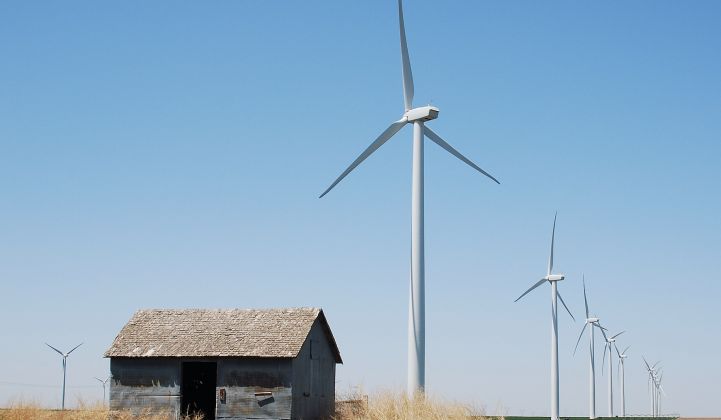The middle of the United States continues driving wind prices lower. Cheap projects located in the country’s windy center have drawn the national average down to $20 per megawatt-hour, according to a new report from the Department of Energy’s Office of Energy Efficiency and Renewable Energy.
The report calculates a decline in average wind prices from about $70 per megawatt-hour in 2009, to $20 per megawatt-hour in 2017 — a $50 decline in an eight-year period.
While the drop was less pronounced in the U.S.’ most resource-rich wind zone — the prices in the middle of the country fell from $55 per megawatt-hour to a bit below $20 per megawatt-hour in that same time — the overall price declines are drastic.
Bigger turbines have enhanced wind project performance, while lower turbine pricing continues to push down installed project costs. The average installed cost of wind projects in 2017 was $1,610 per kilowatt, down $795 per kilowatt from the peak in 2009, according to the DOE report.
But comparatively tough times are ahead. Analysts call the federal Production Tax Credit a “core motivator for wind power deployment,” and the credit will phase down through 2024.
The latest North America Wind Power Outlook published this month by Wood Mackenzie Power & Renewables notes that the PTC makes wind the cheapest new generation source, in comparing levelized costs of energy, across most of the country. According to WoodMac, wind has declined by a “striking” 5 percent over the last four years. DOE attributes those declines to higher capacity factors, low interest rates and declining installation costs.
The expiration of the PTC will temper those declines to a slower 3 percent compound annual growth rate through 2027. Comparatively, solar costs will continue falling, helped along by the federal Investment Tax Credit. WoodMac's base case suggests that solar could undercut wind prices through 2027.
Even with that challenge, the Outlook found that post-PTC wind will still come in cheaper than new combined-cycle natural gas in 20 states. That will bloom to 28 states in 2027.
The DOE reports that all low-cost projects are located in the U.S. “wind belt,” where wind speeds can top 8.5 meters per second. The interior of the country has the most projects, and they are all clustered on the lower end for levelized costs of energy.

Source: Department of Energy Office of Energy Efficiency and Renewable Energy
The 7.5 gigawatts of projects in the West and the 1.5 gigawatts in the Northeast are no match for costs in the interior of the country, where PPA prices now consistently cluster around $20 per megawatt-hour.
Those interior projects are also consistently beating gas price projections from the Energy Information Administration.
According to DOE, wind additions will still increase in the short term from 8 gigawatts in 2018 to 10 to 13 gigawatts in 2020. Then 2021 through 2025 will bring a downturn, in part because of the phaseout of the PTC.
“At the same time,” the DOE report notes, “the potential for continued technological advancements and cost reductions enhance the prospects for longer-term growth, as does burgeoning corporate demand for wind energy and continued states RPS requirements.”
Authors also write that 26 near-term transmission projects could help development along.
While the industry is gearing up for “an unprecedented installation boom” in the short term, WoodMac also notes the coming “demand hangover” from the PTC phase-down. Analysts said continuing downturns in cost, as well as coal retirements and offshore wind projects, will keep pushing the market forward.




